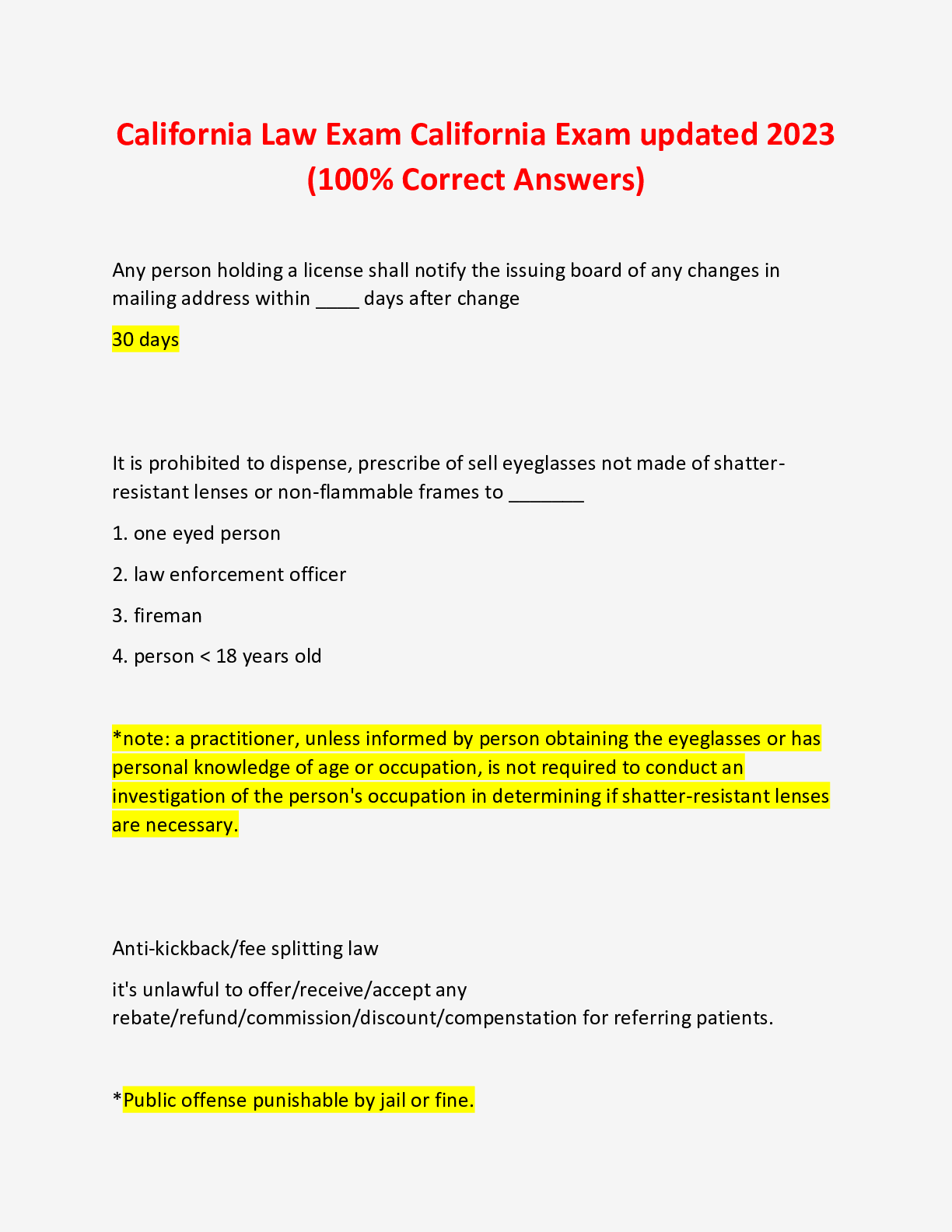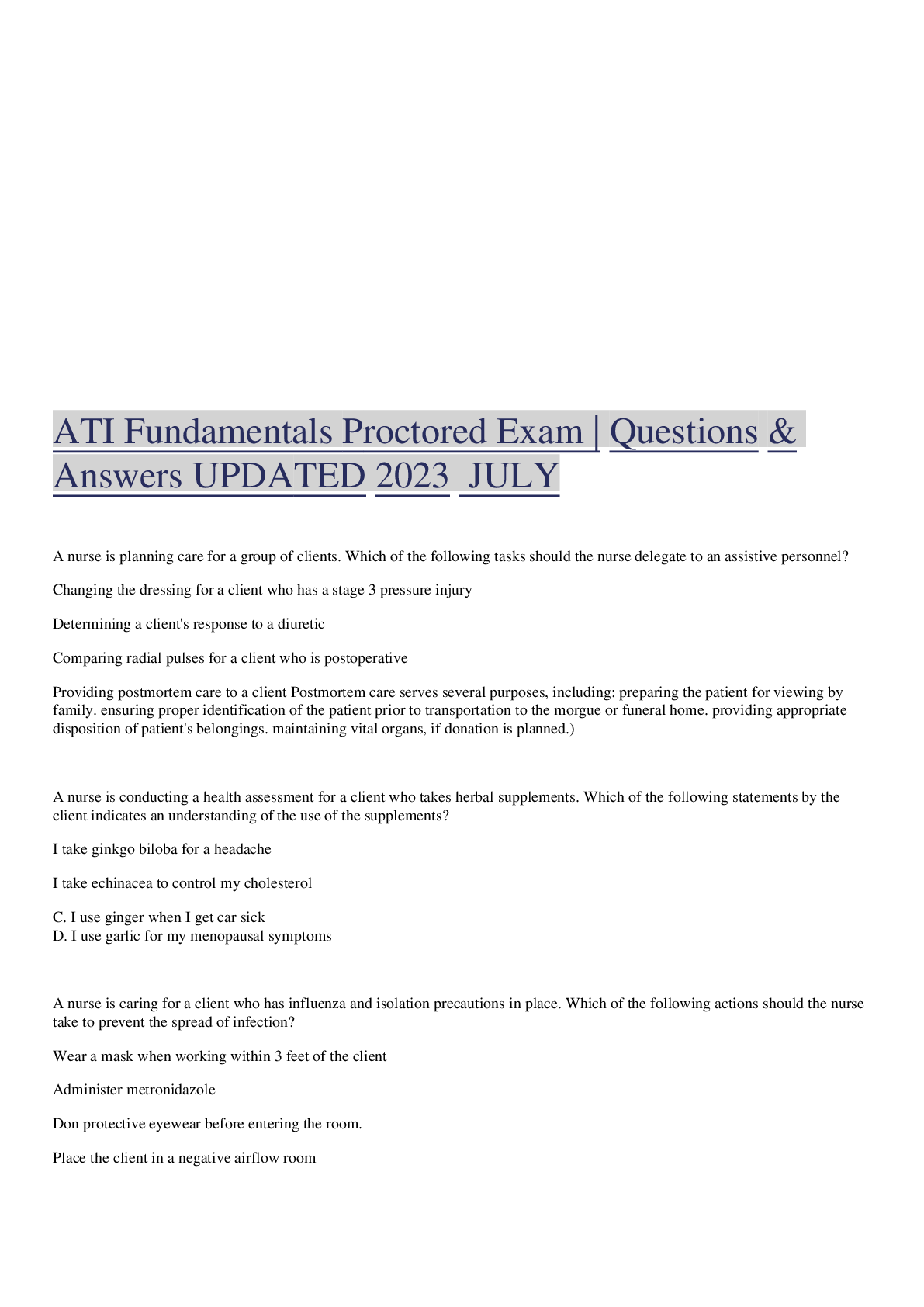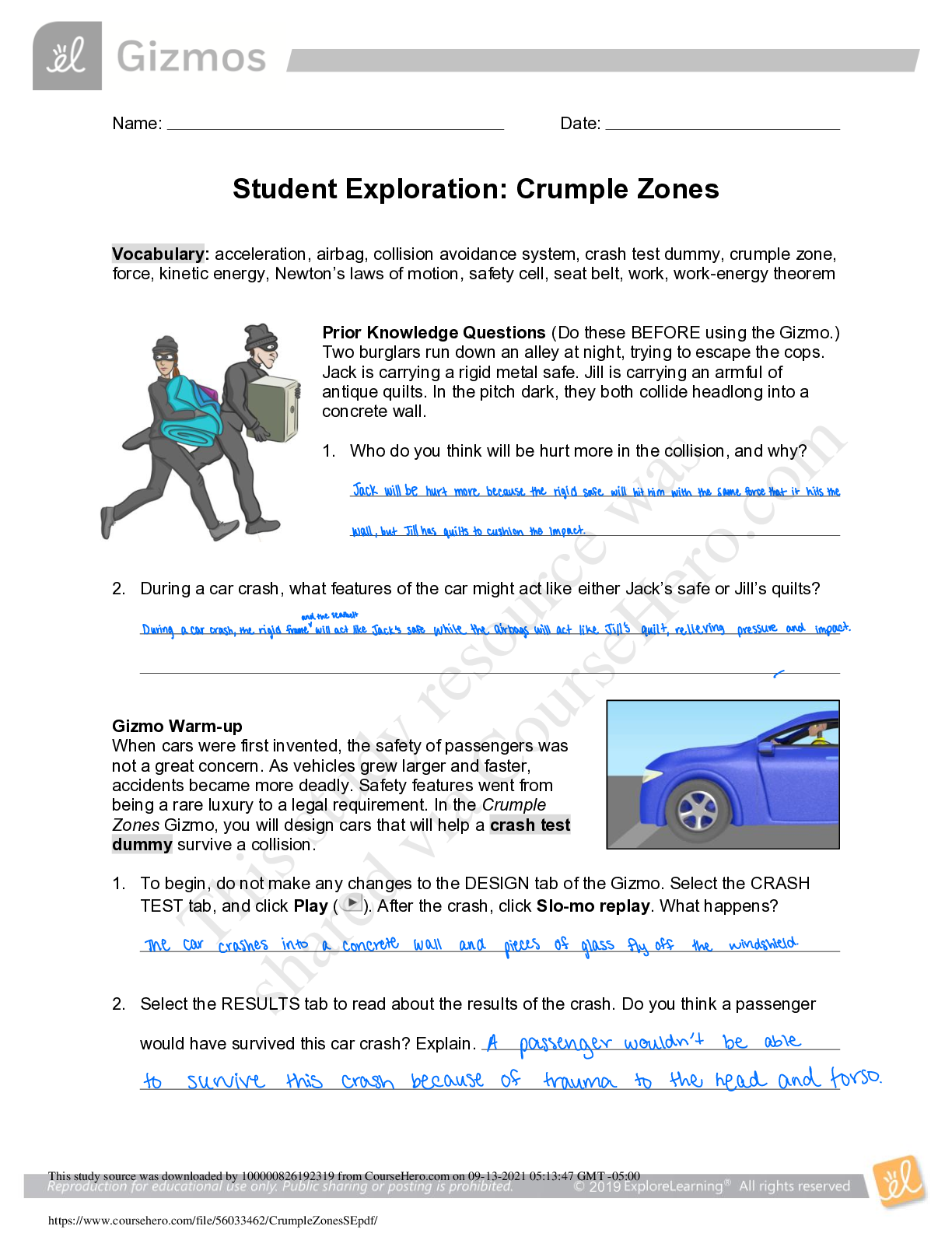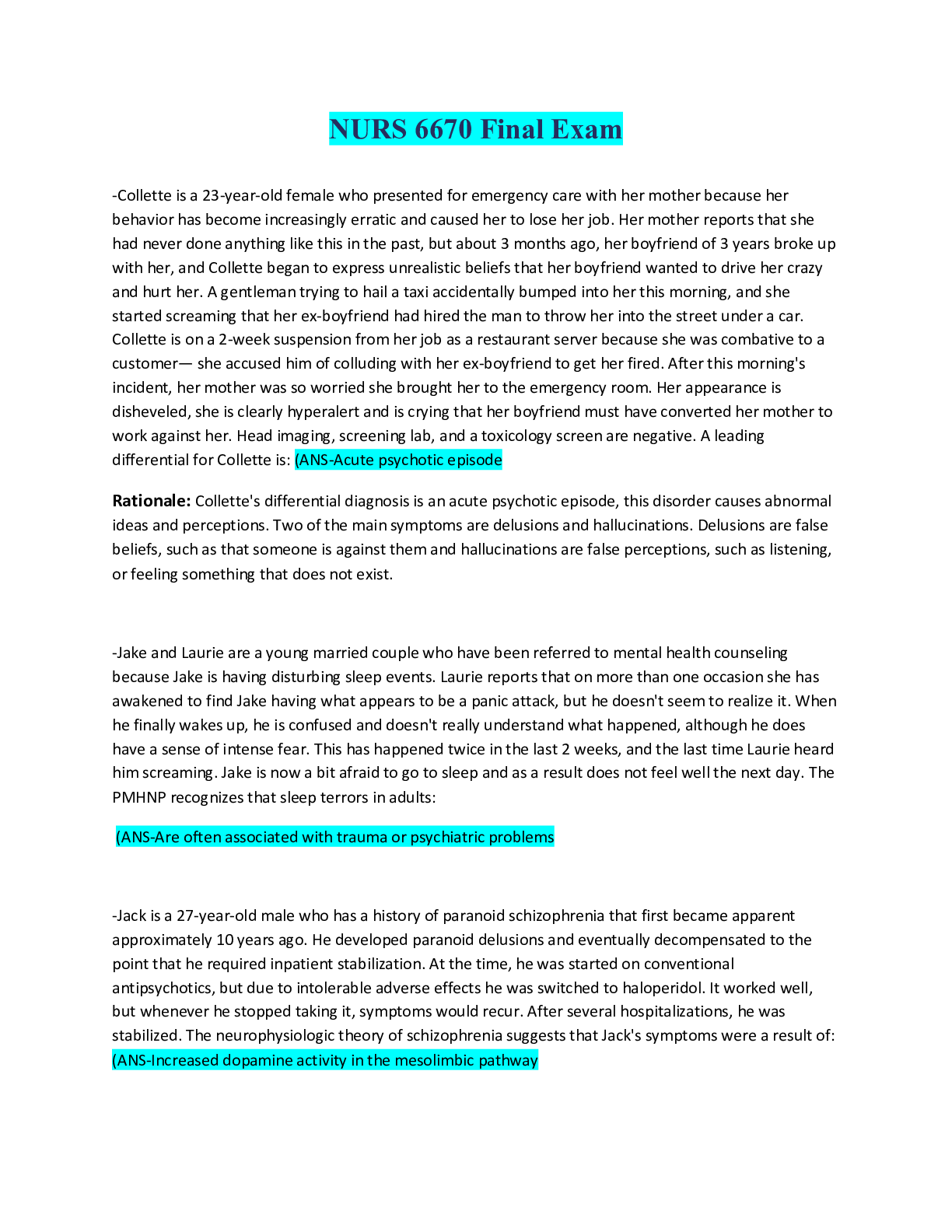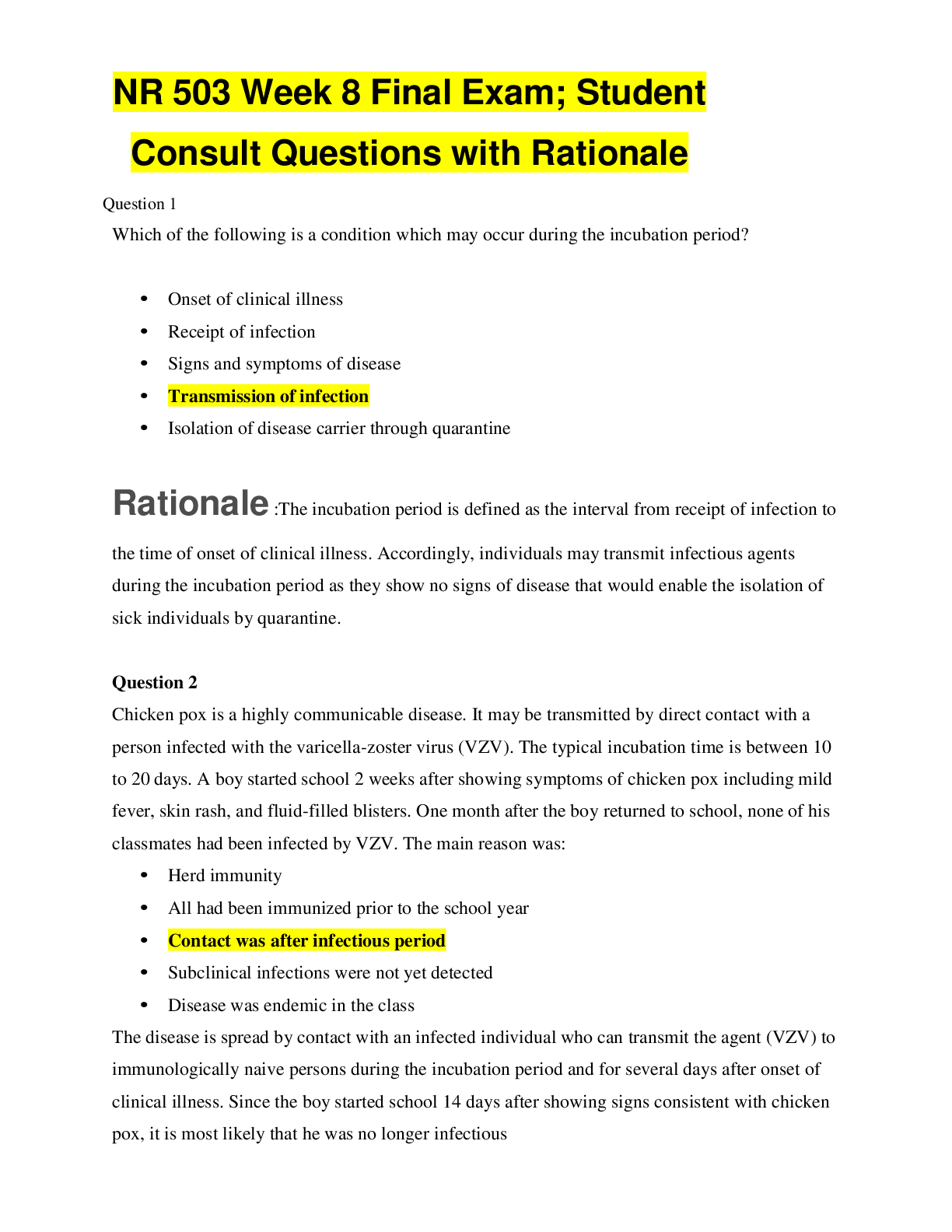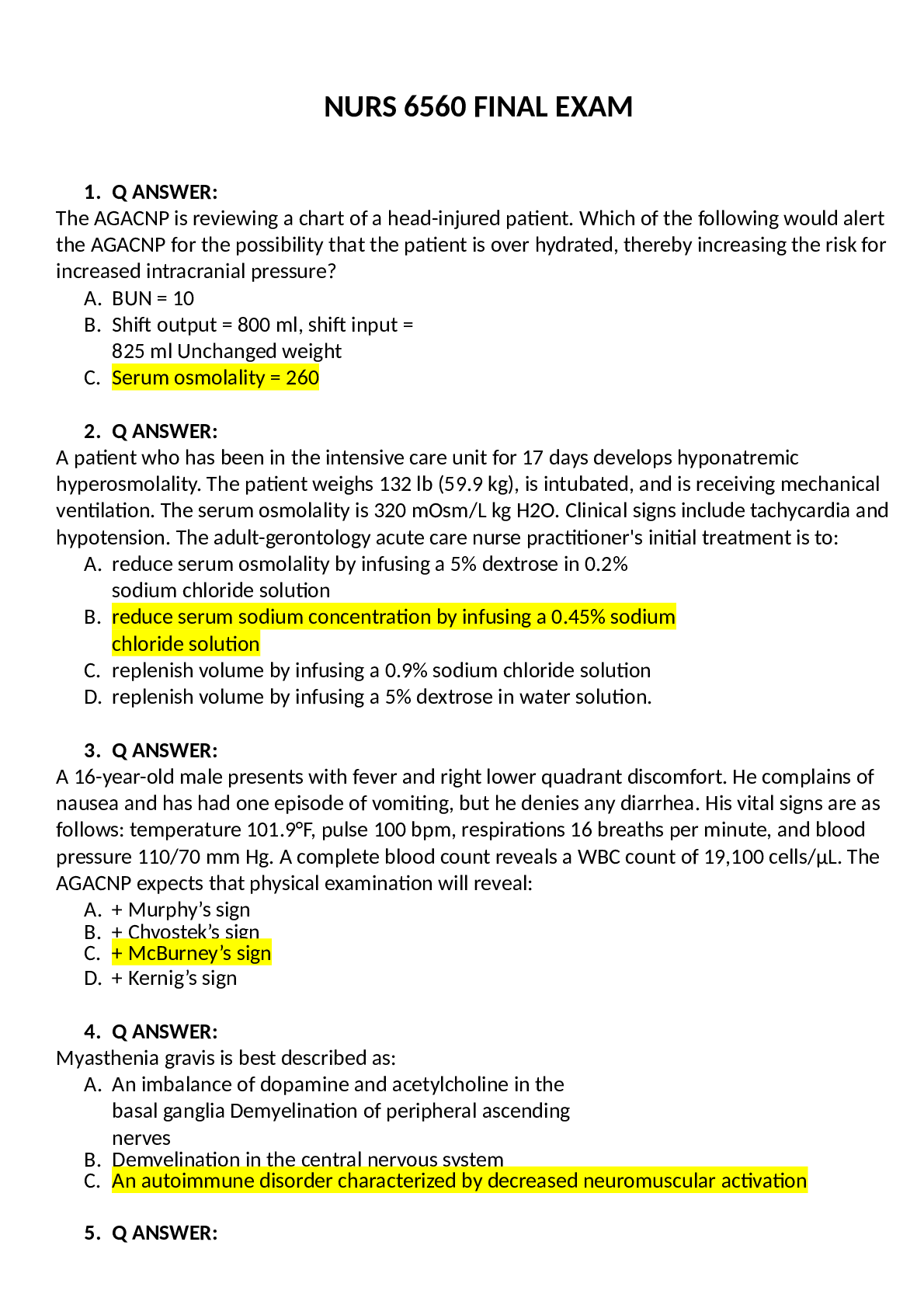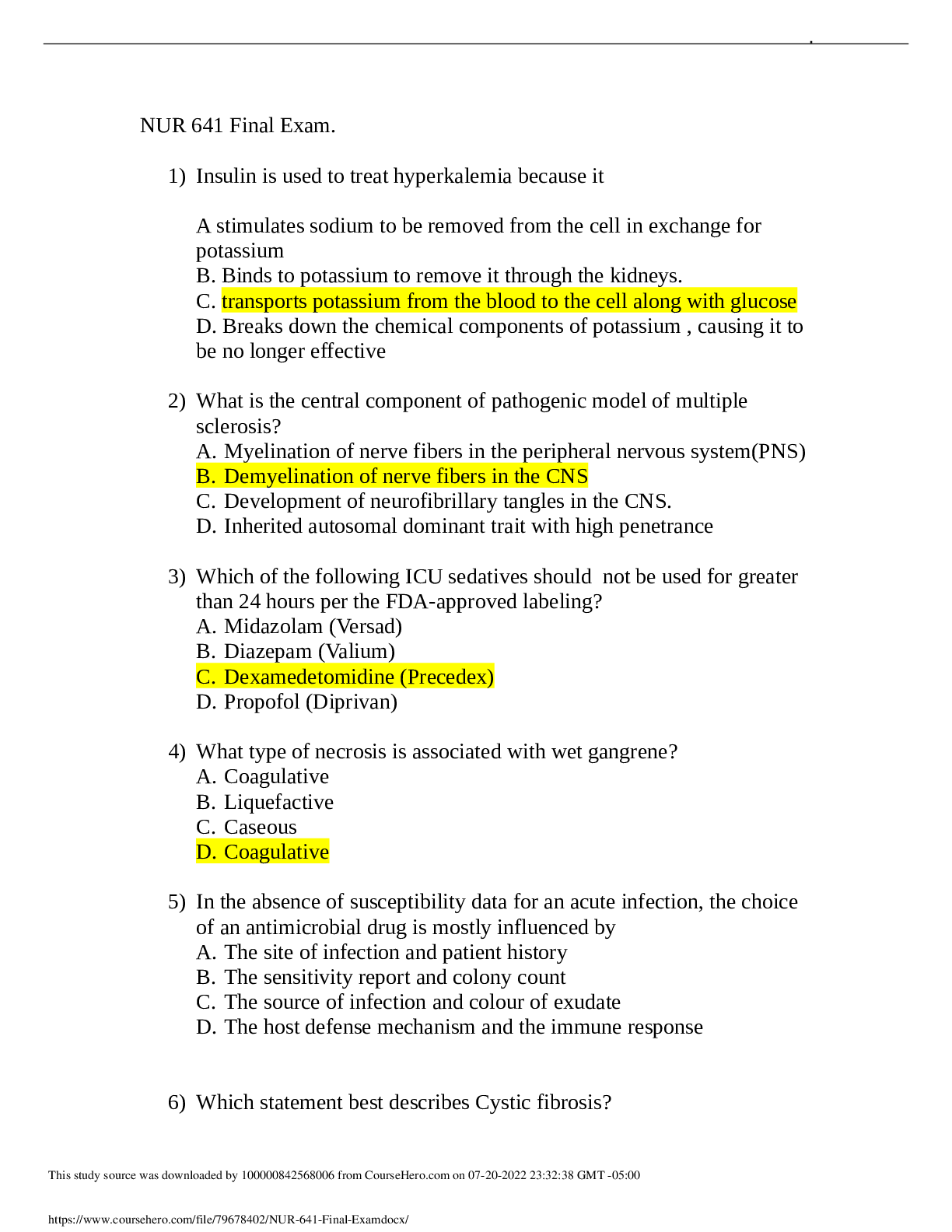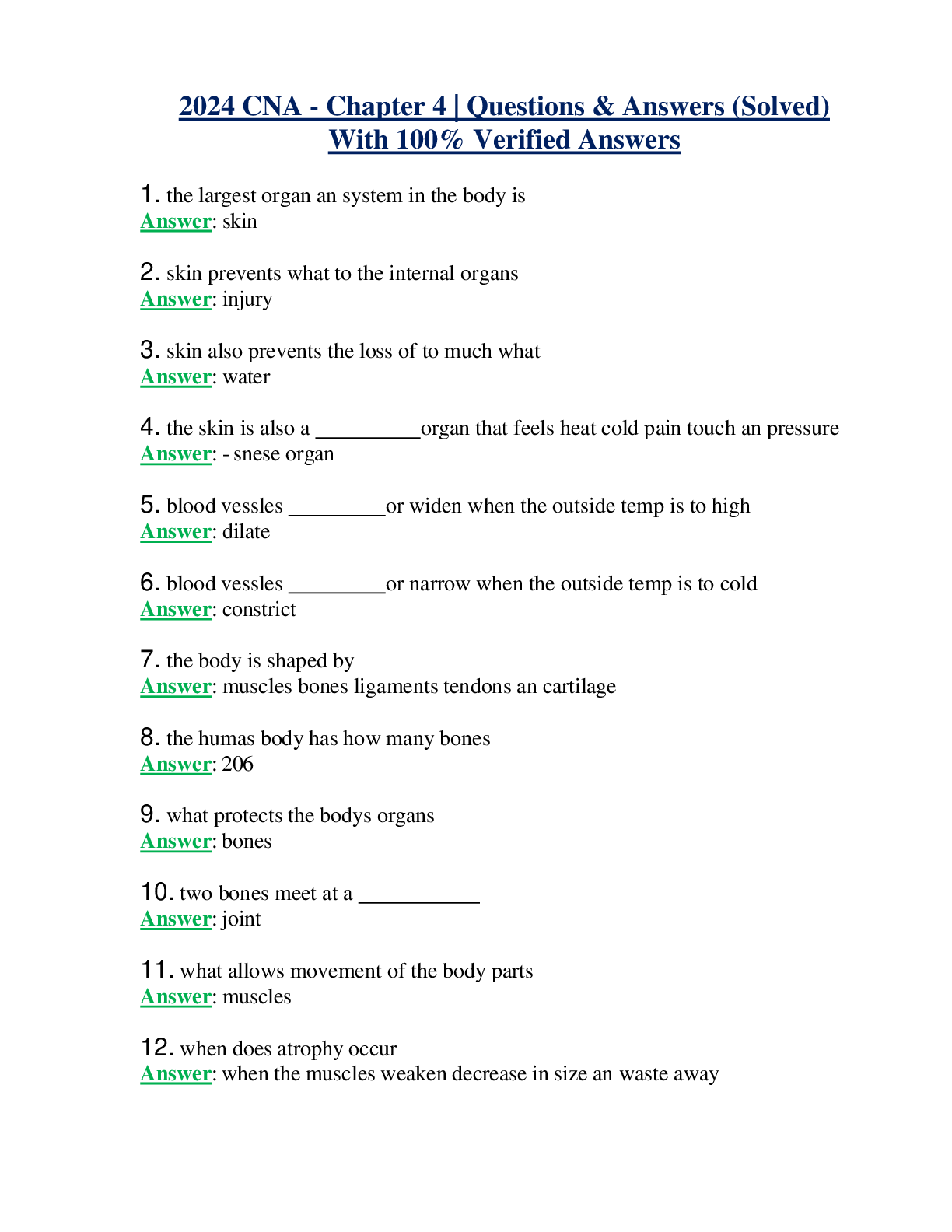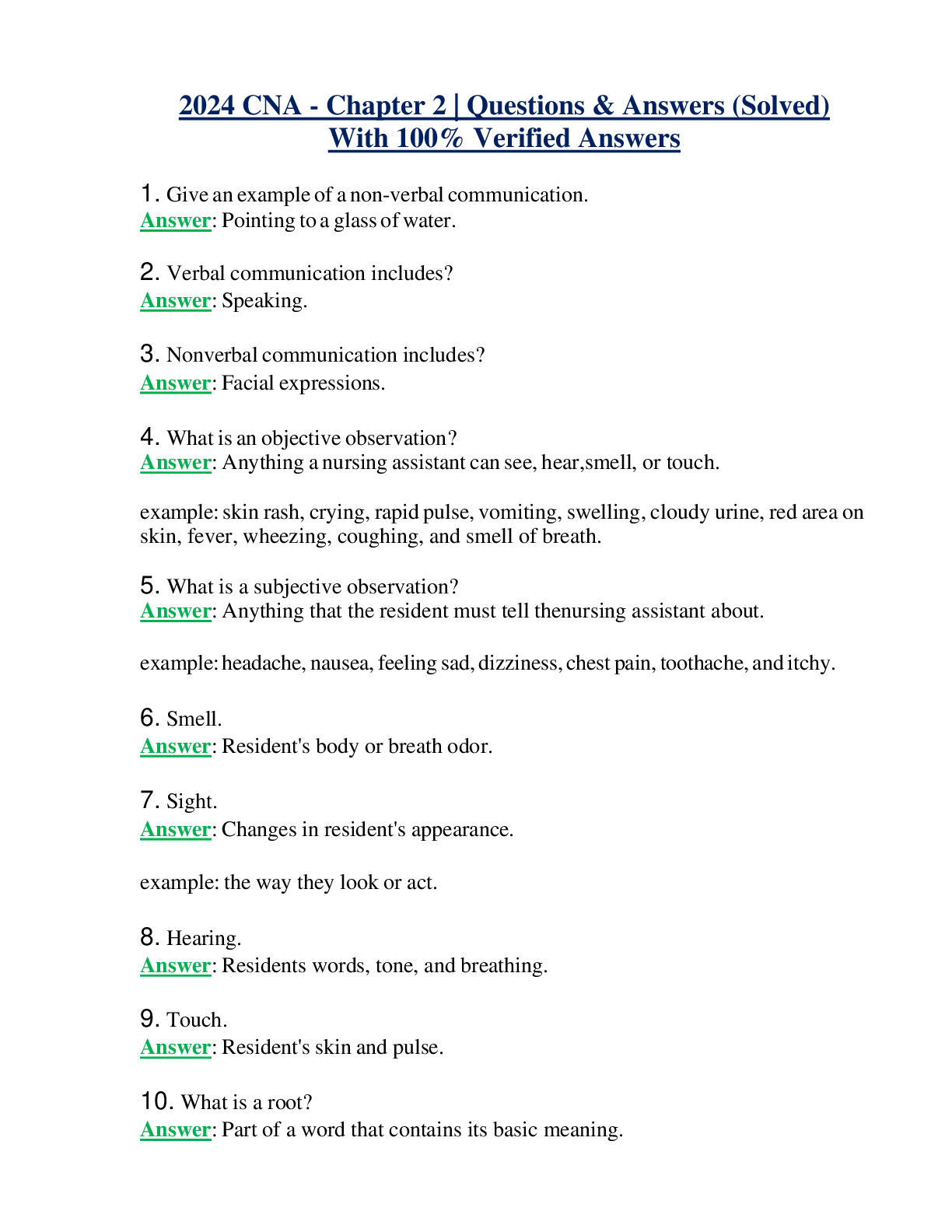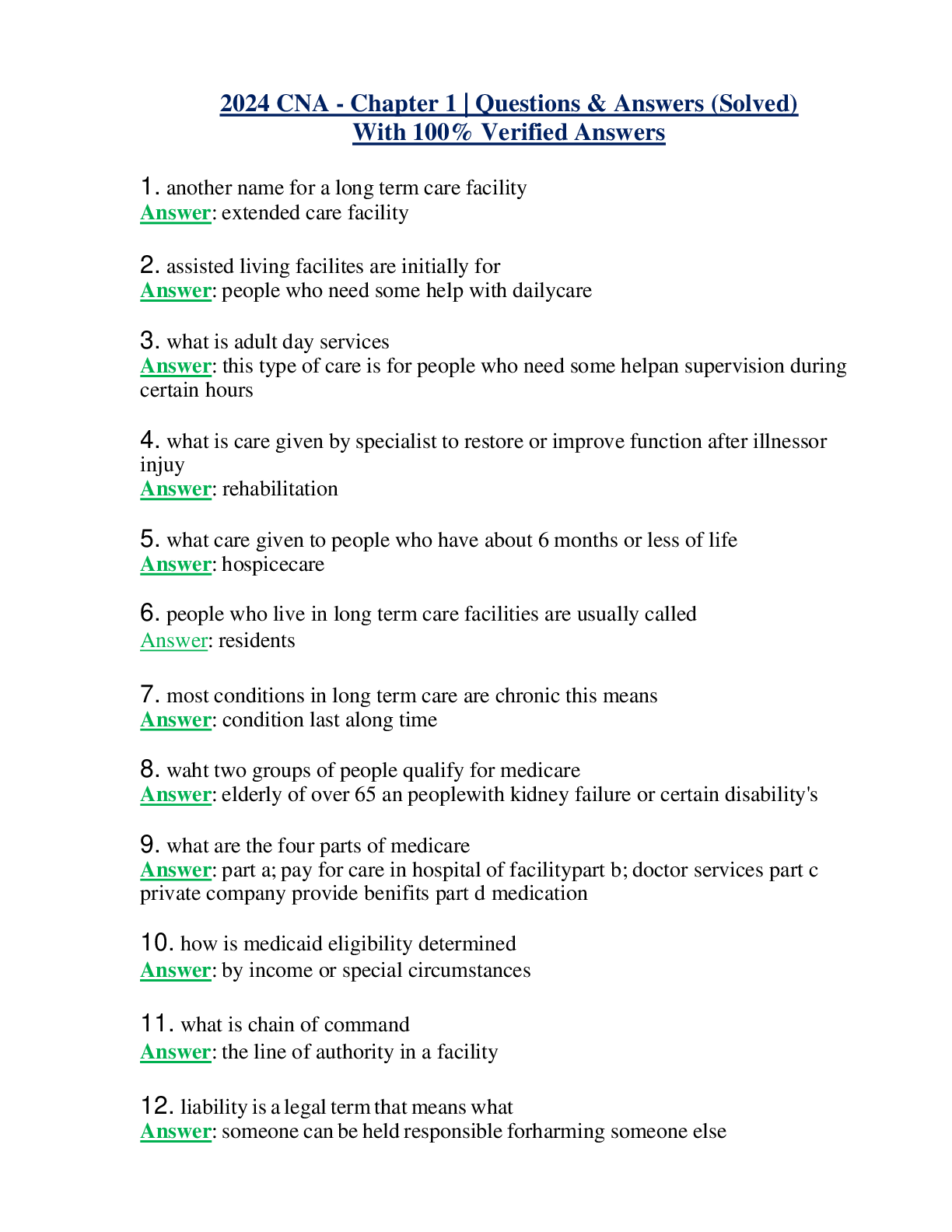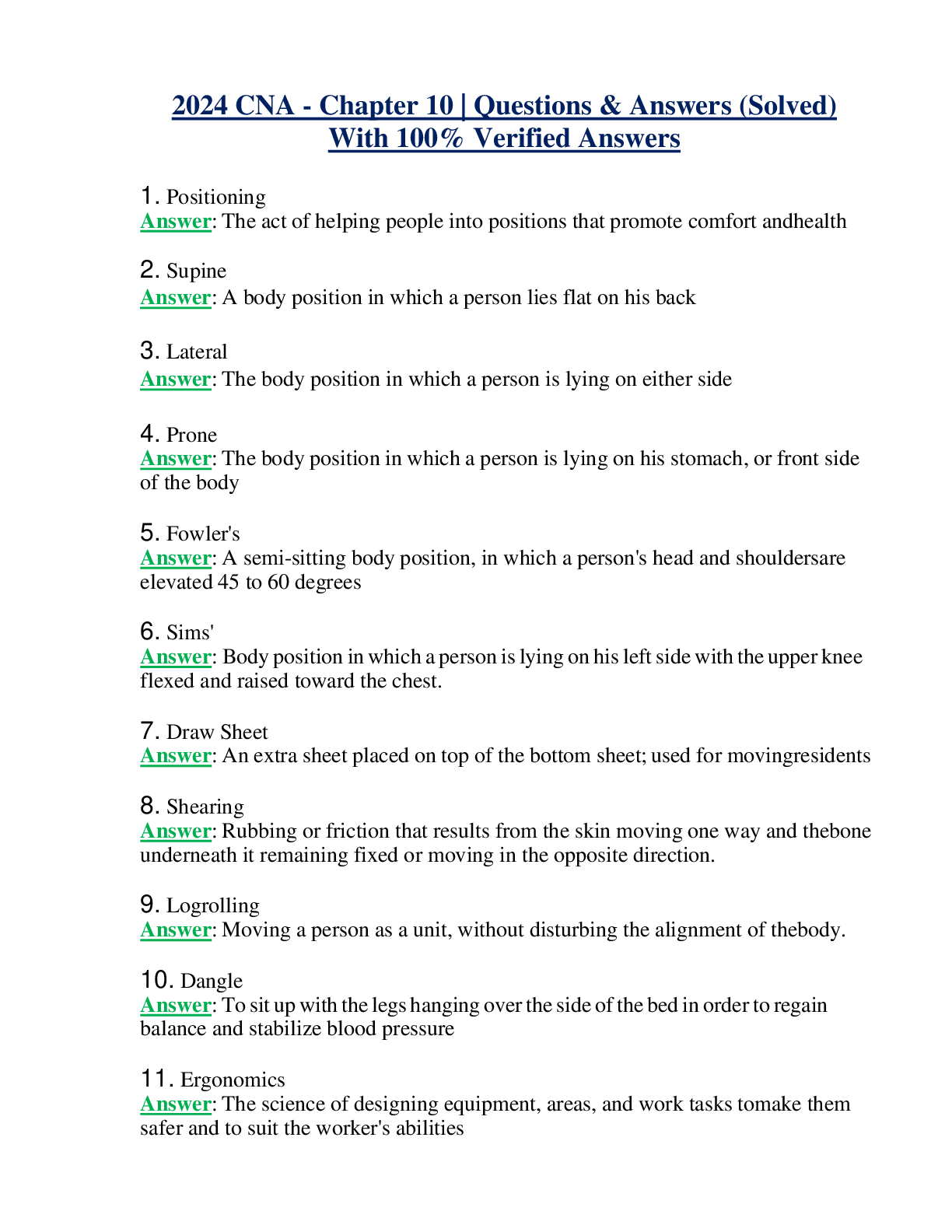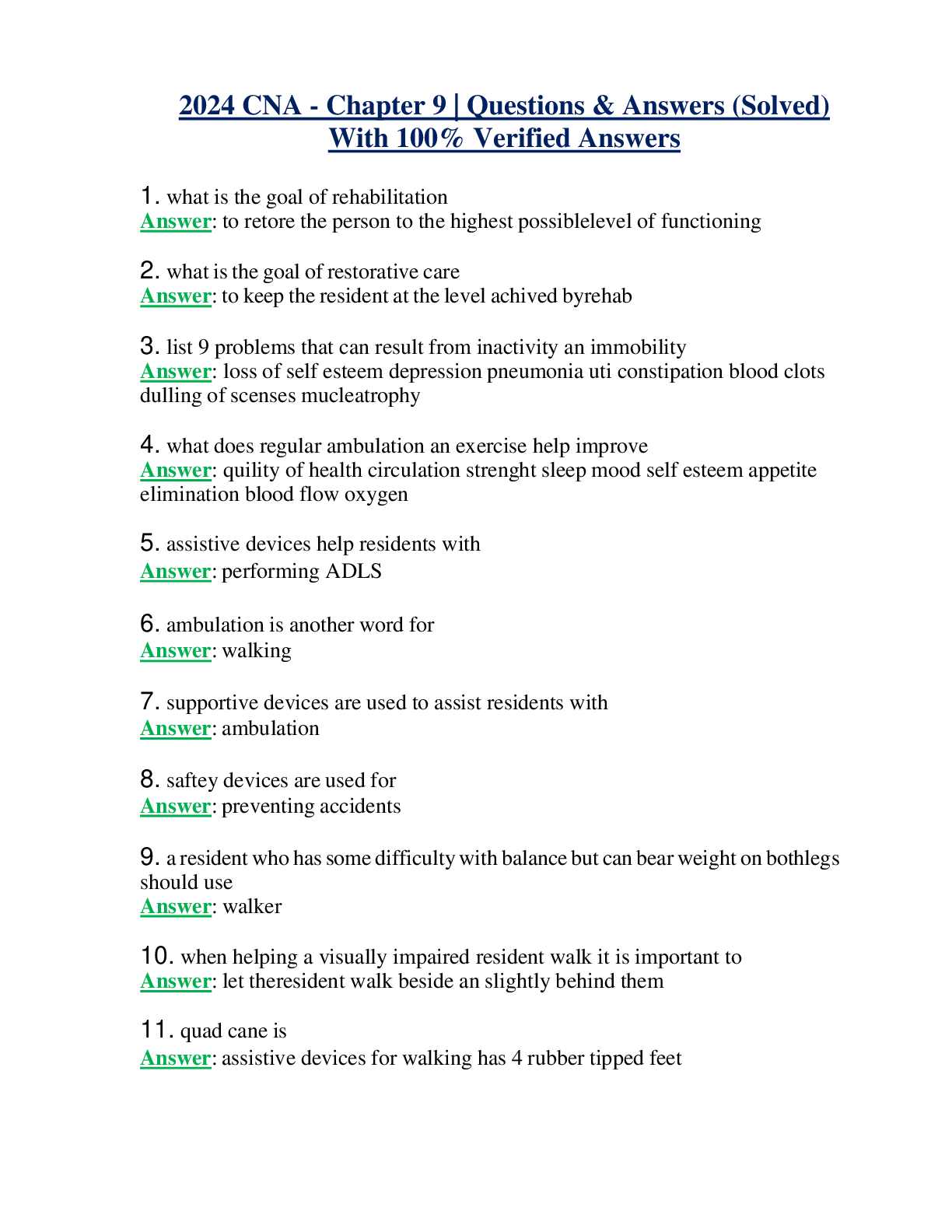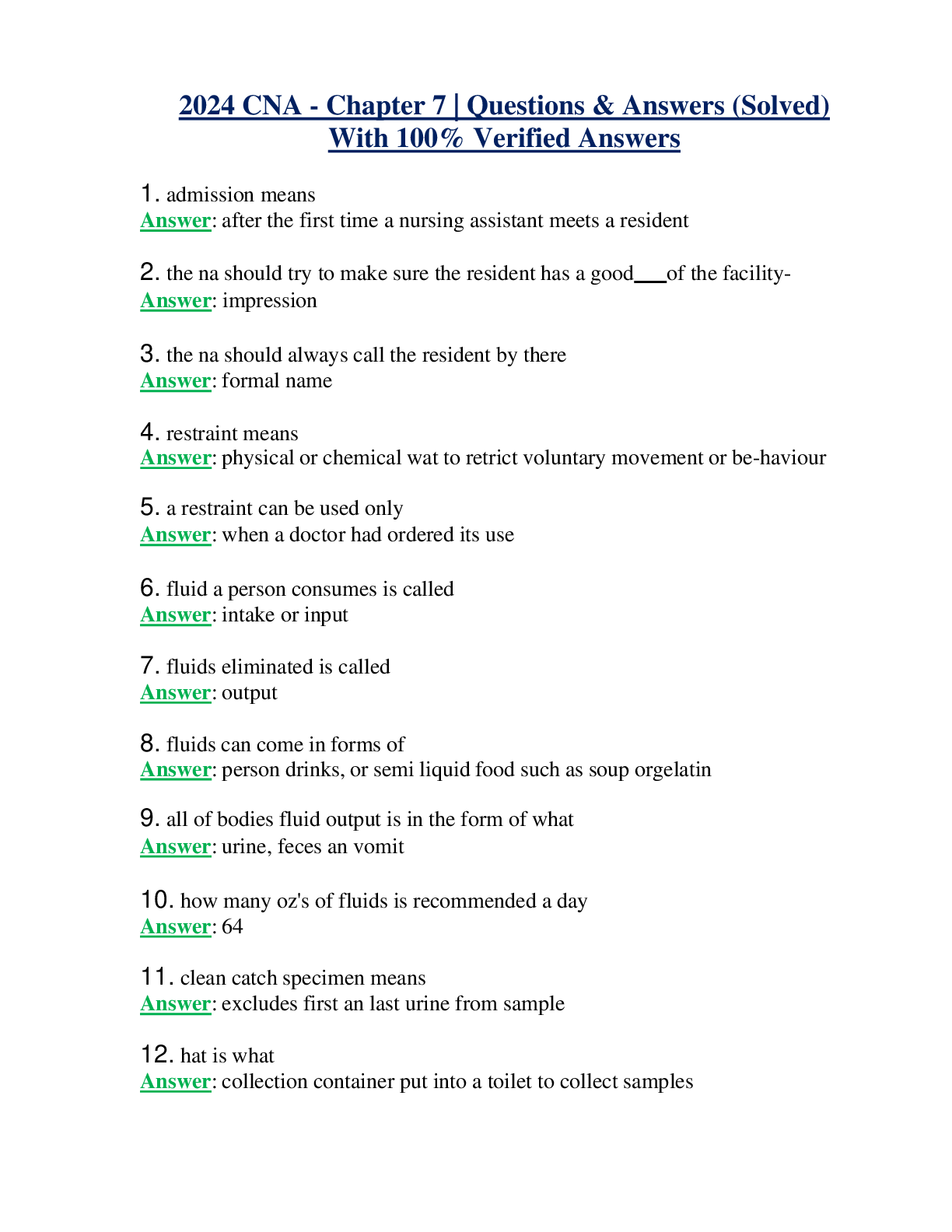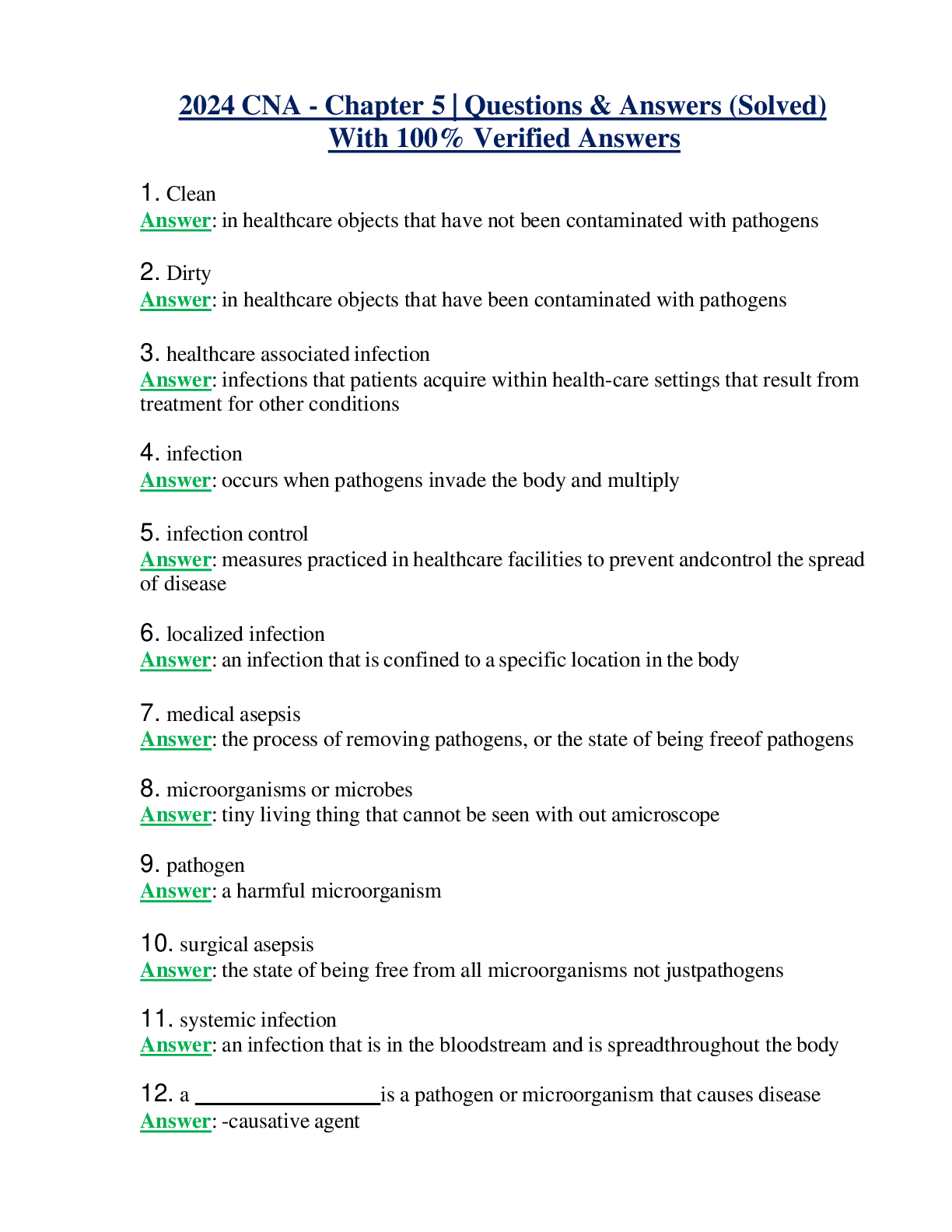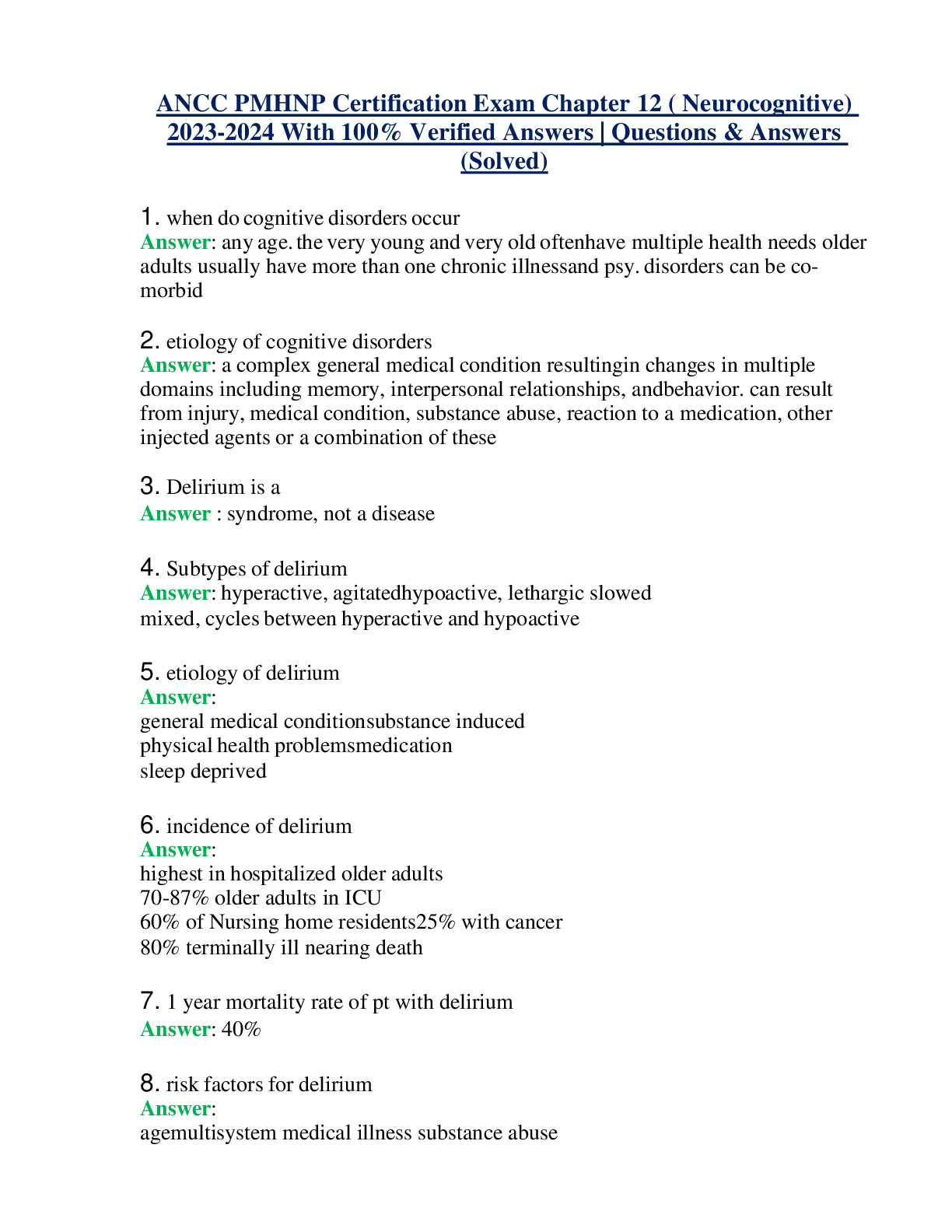Pharmacology > EXAM > NURSING NU1426 PHARMOCOLOGY Final Exam | Questions & Answers (Graded A+). (All)
NURSING NU1426 PHARMOCOLOGY Final Exam | Questions & Answers (Graded A+).
Document Content and Description Below
Q.1) You are responsible for reviewing the nursing unit's refrigerator. If you found the following drug in the refrigerator it should be removed from the refrigerator's contents? A. Corgard (Corr... ect Answer) B. Humulin (injection) C. Urokinase (Your Answer) D. Epogen (injection) Q.2) A patient has taken an overdose of aspirin. Which of the following should a nurse most closely monitor for during acute management of this patient? A. Onset of pulmonary edema B. Metabolic alkalosis (Your Answer) C. Respiratory alkalosis D. Parkinson’s disease type symptoms (Correct Answer) Q.3) The client with cardiac disease is prescribed amiodarone (Cordarnoe), an antidysrhythmic, orally. Which teaching intervention should the nurse implement? A. Notify the health-care provider of dyspnea, fatigue, and cough. (Your Answer) B. Instruct the client to take the medication prior to going to bed. C. Tell the client not to take the medication if the apical pulse is less than 60. D. Explain that this medication may cause the stool to turn black. Q.4) The nurse is administering 0800 medications. Which medication would the nurse question? A. Misoprostol (Cytotec), a prostaglandin analog, to a 29-year-old male with an NSAID-produced ulcer. B. Omeprazole (Prilosec), a proton-pump inhibitor, to a 68-year-old male with a duodenal ulcer. C. Furosemide (Lasix), a loop diuretic, to a 56-year-old male with a potassium level of 3.0mEq/L. (Your Answer) D. Acetaminophen (Tylenol), a nonnarcotic analgesic to an 84 year old with a frontal headache. Q.5) The client diagnosed with coronary artery disease is prescribed atorvastatin (Lipitor), an HMG-CoA reductase inhibitor. Which statement by the client indicates the medication is effective? A. �I really haven’t changed my diet, but I am taking my medication every day.” B. �I am feeling good since my doctor told me my cholesterol level came down.” (Correct Answer) C. �I am swimming at the local pool about three times a week for 30 minutes.” (Your Answer) D. �Since I have been taking this medication the swelling in my leg is better.” Q.6) The client diagnosed with chronic obstructive pulmonary disease is prescribed methylprednisolone (Solu-Medrol), a glucocorticoid, IVP. Which laboratory data would warrant immediate intervention by the nurse? A. The white blood cell count is 15,000. (Correct Answer) B. The hemoglobin and hematocrit levels are 13 g/dL and 39% C. The blood glucose level is 138 mg/dL. D. The creatinine level is 1.3 mg/dL (Your Answer) Q.7) Which statement best describes the scientific rational for administrating a miotic ephthalmic medication to a client diagnosed with glaucoma? A. It constricts the pupil, which causes the pupil to dilate in low light. (Correct Answer) B. It dilates the pupil to reduce the production of aqueous humor. C. It decreases production of aqueous humor but does not affect the eye. (Your Answer) D. It is used as adjunctive therapy primarily to reduce intraocular pressure. Q.8) Each of the following clients has ahead injury. To which client would the nurse question administering the osmotic diuretic mannitol (Osmitrol)? A. The 34-year-old client who is HIV positive. (Your Answer) B. The 84 year old client who has glaucoma C. The 68-year-old client who has congestive heart failure. (Correct Answer) D. The 16-year-old client who has cystic fibrosis. Q.9) The client with a head injury is ordered a CT scan of the head with contrast dye. Which invention should the nurse include when discussing procedure? A. Instruct the client to not take any of the routine medications. B. Inform the client an intravenous line will be started prior to the procedure. (Correct Answer) C. Ask about any allergies to nonsteroidal anti-inflammatory medication. D. Explain that the client will be given sedatives prior to the procedure. (Your Answer) Q.10) Which statement best describes the scientific rationale for prescribing the thiazolidinedione pioglitazone (Actos)? A. This medication increases glucose uptake in the skeletal muscles and adipose tissue. (Your Answer) B. This medication allows the carbohydrates to pass slowly through the large intestine. C. This medication will decrease the hepatic production of glucose from stored glycogen. D. This medication stimulates the beta cells to release more insulin into the bloodstream Q.11) A nurse is preparing the client's morning NPH insulin dose and notices a clumpy precipitate inside the insulin vial. The nurse should: A. Draw up and administer the dose (Your Answer) B. Shake the vial in an attempt to disperse the clumps C. Draw the dose from a new vial (Correct Answer) D. Warm the bottle under running water to dissolve the clump Q.12) The client is discussing wanting to quit smoking cigarettes with the clinic nurse. Which intervention is most successful in helping the client to quit smoking cigarettes? A. Encourage the client to attend a smoking cessation support group. (Your Answer) B. Discuss tapering the number of cigarettes smoked daily. C. Instruct the client to use varenicline (Chantix), a smoking cessation medication. (Correct Answer) D. Explain that clonidine can be taken daily to help decrease withdrawal symptoms. Q.13) The nurse is administering Augmentin to her patient with a sinus infection. Which is the best way for her to insure that she is giving it to the right patient? A. Call the patient by name (Your Answer) B. Read the name of the patient on the patient’s door C. Check the patient’s wristband (Correct Answer) D. Check the patient’s room number on the unit census list Q.14) Which intervention should the nurse implement when administering the biologic response modifier filgrastim (Neupogen) subcutaneously? A. Shake the vial well prior to preparing the injection. B. Apply a warm washcloth after administering the medication. C. Discard any unused portion of the vial after withdrawing the correct dose. (Your Answer) D. Keep the medication vials in the freezer until preparing to administer. Q.15) A contraindication for topical corticosteroid usage in a male patient with atopic dermatitis (eczema) is: A. Parasite infection. (Your Answer) B. Viral infection. (Correct Answer) C. Bacterial infection D. Spirochete infection. Q.16) The charge nurse on an orthopedic unit is transcribing orders for a client diagnosed with back pain. Which HCP order should the charge nurse question? A. Morphine sulfate, a narcotic analgesic, Q 4 hours ATC. (Correct Answer) B. CBC and CMP (complete metabolic panel). C. Hydrocodone (Vicodin), an opioid analgesic, Q 4 hours PRN. D. Carisoprodol (Soma), a muscle relaxant, po, B.I.D. (Your Answer) Q.17) The nurse is administering medications to clients on an orthopedic unit. Which medication should the nurse question? A. Ibuprofen (Motrin), an NSAID, to a client diagnosed with back pain. (Your Answer) B. Morphine, an opioid analgesic, to a client with a “2” back pain on the pain scale. (Correct Answer) C. Methocarbamo (Robaxin), a muscle relaxant, to a client with chronic back pain. D. Propoxyphene (Darvon N), a narcotic, to a client with mild back pain. Q.18) The client's arterial blood gas results are pH 7.35, PaO2 75, PCO2 35, and HCO3 24. Which action would be most appropriate for this client? A. Administer oxygen 10 L/min via nasal cannula. (Your Answer) B. Administer and antianxiety medication. C. Administer 1 amp of sodium bicarbonate IVP. D. Administer 30 mL of an antacid. Q.19) To which client would the nurse expect the health-care provider to prescribe chlordiazepoxide (Librium), a benzodiazepine? A. A client addicted to cocaine. B. A client addicted heroin. (Your Answer) C. A client addicted to amphetamines. D. A client addicted to alcohol. (Correct Answer) Q.20) The client experienced a full-thickness burn to 45% of the body including the chest area. The HCP ordered fluid resuscitation. Which data indicates the fluid resuscitation has been effective? A. The client’s urine output is less than 30mL/hour. B. The client’s has productive cough and clear lungs. (Your Answer) C. The client’s blood pressure is 110/70. (Correct Answer) D. The client’s urine contains sediment. Q.21) The nurse is administering 0900 medications to the following clients. To which clients would the nurse question administering the medication? A. The client receiving a calcium channel blocker who drank a full glass of water. B. The client receiving a beta blocker who has a blood pressure of 96/70. C. The client receiving a nitro glycerin patch who is complaining of a headache. (Your Answer) D. The client receiving an antiplatelet medication who has a platelet count of 33,000. (Correct Answer) Q.22) The client is experiencing yentricular tachycardia and has a weak, thread apical pulse. Which medication should the nurse prepare to administer to the client? A. Epinephrine, an adrenergic agonist, intravenous push. B. Lidocaine, an antidysrhythmic, intravenous push. (Correct Answer) C. Atropine, an antdysrhythmic, intravenous push. D. Digoxin, a cardiac glycoside, intravenous push. (Your Answer) Q.23) A client is taking famotidine (Pepcid) asks the home care nurse what would be the best medication to take for a headache. The nurse tells the client that it would be best to take: A. Aspirin (acetylsalicylic acid, ASA) (Your Answer) B. Ibuprofen (Motrin) C. Acetaminophen (Tylenol) (Correct Answer) D. Naproxen (Naprosyn) Q.24) A second year nursing student has just suffered a needlestick while working with a patient that is positive for AIDS. Which of the following is the most important action that nursing student should take? A. Immediately see a social worker B. Start prophylactic AZT treatment (Correct Answer) C. Start prophylactic Pentamide treatment D. Seek counseling (Your Answer) Q.25) A thirty five year old male has been an insulin-dependent diabetic for five years and now is unable to urinate. Which of the following would you most likely suspect? A. Atherosclerosis (Your Answer) B. Diabetic nephropathy C. Autonomic neuropathy (Correct Answer) D. Somatic neuropathy Q.26) Mr. Jessie Ray, a newly admitted patient, has a seizure disorder which is being treated with medication. Which of the following drugs would the nurse question if ordered for him? A. Phenobarbitol, 150 mg hs (Your Answer) B. Amitriptylene (Elavil), 10 mg QID. (Correct Answer) C. Valproic acid (Depakote), 150 mg BID D. Phenytoin (Dilantin), 100 mg TID Q.27) The nurse is preparing to administer medications to the following clients. Which medication would the nurse question administering? A. The loop diuretic furosemide (Lasix) to the client with a serum potassium level of 4.2 mEq/L. B. The osmotic dinretic mannitol (Osmitrol) to the client with a serum osmolality of 280 mOsm/kg. C. The cardiac glycoside digoxin (Lanoxin) to the client with a digoxin level of 1.2 mg/dL. D. The anticonvulsant phenytoin (Dilantin) to the client with a Dilantin level of 24 ug/mL. (Your Answer) Q.28) Mandy, a patient calls the clinic today because he is taking atrovastatin Lipitor to treat his high cholesterol and is having pain in both of his legs. You instruct him to: A. Stop taking the drug and make an appointment to be seen next week. B. Continue taking the drug and make an appointment to be seen next week. C. Stop taking the drug and come to the clinic to be seen today. (Correct Answer) D. Walk for at least 30 minutes and call if symptoms continue. (Your Answer) Q.29) The obstetric clinic nurse is discussing folic acid, a vitamin, with a client who is trying to conceive. Which information should the nurse discuss with the client when taking this medication? A. Do not use any laxatives containing mineral oil when taking folic acid. B. The client should drink one glass of red wine daily to potentiate the medication. C. This medication will help prevent spina bifida in the unborn child. (Your Answer) D. Notify the health-care provider if the client’s vision becomes blurry. Q.30) A patient has recently experienced a (MI) within the last 4 hours. Which of the following medications would most like be administered? A. Streptokinase (Correct Answer) B. Atropine (Your Answer) C. Acetaminophen D. Coumadin Q.31) The nurse is administering digoxin (Lanoxin) 0.25 mg intravenous push medication to the client. Which intervention should the nurse implement? A. Administer the medication undiluted in a 1-mL syringe. B. Check the client’s potassium level. (Correct Answer) C. Pinch off the intravenous tubing below the port D. Inject the medication quickly and at a steady rate. (Your Answer) Q.32) The nurse is caring for clients diagnosed with acquired immunodeficiency syndrome (AIDS). Which action by the unlicensed assistive personal (UAP) warrants immediate action by the nurse? A. The UAP uses nonsterile gloves to empty a client’s urinal. (Your Answer) B. The UAP is helping a client take OTC herbs brought from home. (Correct Answer) C. The UAP provides a tube of moisture barrier cream to a client. D. The UAP fills a client’s water pitcher with ice and water. Q.33) The nurse is preparing to administer medications on a pulmonary unit. Which medication should the nurse administer first? A. Prednisone, a glucocorticoid, for a client diagnosed with chronic bronchitis. B. Ceftriaxone (Rocephin), an intravenous antibiotic, an initial dose (ID). (Correct Answer) C. Lactic acidophilus (Lactinex) to a client receiving IVPB antibiotics. (Your Answer) D. Cephalexin (Keflex) po, an antibiotic, to a client being discharged. Q.34) The client with major depressive disorder is prescribed the selective serotonin reuptake inhibitor (SSRI) fluoxetine (Prozac). Which intervention should the nurse teach the client concerning this medication? A. Instruct the client not to eat any type of tyramine-containing foods such as wines or cheeses. (Your Answer) B. Notify the health-care provider if the client becomes anxious or has an elevated temperature. (Correct Answer) C. Encourage the client to take the medication with grapefruit juice. D. Explain that tremors and sweating are initial expected side effects. Q.35) The elderly client diagnosed with coronary artery disease has been taking aspirin daily for more than a year. Which data would warrant notifying the health-care provider? A. The client has lost 5 pounds in the last month. B. The client has trouble hearing low tones. C. The client reports having a funny taste in the mouth. D. The client is complaining about bleeding gums. (Your Answer) Q.36) When you are taking a patient's history, she tells you she has been depressed and is dealing with an anxiety disorder. Which of the following medications would the patient most likely be taking? A. Elavil (Your Answer) B. Calcitonin C. Pergolide D. Verapamil Q.37) Then nurse is caring for clients on the telemetry unit. Which medication should the nurse administer first? A. The cardiotonic digoxin to the client diagnosed with CHF whose digoxin level is 1.9 mg/dL B. The marcotice morphine IVP to the client who has pleurtice chest pain that is a “7” on a 1-10 pain scale. (Correct Answer) C. The sodium channel blocker lidocaine to the client exhibiting two unifocal PVCs per minute. D. The ACE inhibitor lisinopril (Vasotec) to the client diagnosed with HTN who has a B/P of 130/68. (Your Answer) Q.38) Which of the following adverse effects is associated with levothyroxine (Synthroid) therapy? A. Tachycardia (Correct Answer) B. Bradycardia C. Hypotension (Your Answer) D. Constipation Q.39) Walter, teenage patient is admitted to the hospital because of acetaminophen (Tylenol) overdose. Overdoses of acetaminophen can precipitate life-threatening abnormalities in which of the following organs? A. Lungs B. Liver (Your Answer) C. Kidney D. Adrenal Glands Q.40) You are caring for a patient that dislikes swallowing whole pills. You agree to crush as many of his medications as possible but inform him that some should not be crushed. Which of the following pills must the patient swallow whole? Top of Form Bottom of Form A. Non-coated aspirin (Your Answer) B. Cardizem SR (Correct Answer) C. Prozac D. Amoxicillin Q.41) The client admitted for an acute exacerbation of reactive airway disease is receiving intravenous aminophylline. The client's serum theophylline level is 18 ug/mL. Which action should the nurse implement first? A. Continue to monitor the aminophylline drip. (Your Answer) B. Assess the client for nausea and restlessness. C. Discontinue the aminophylline drip. D. Notify the health-care provider immediately. Q.42) A patient tells you that her urine is starting to look discolored. If you believe this change is due to medication, which of the following patient's medication does not cause urine discoloration? A. Sulfasalazine B. Levodopa C. Phenolphthalein (Your Answer) D. Aspirin (Correct Answer) Q.43) Which of the following adverse effects is specific to the biguanide diabetic drug metformin (Glucophage) therapy? A. Hypoglycemia B. GI distress C. Lactic acidosis (Your Answer) D. Somulence Q.44) The most important instructions a nurse can give a patient regarding the use of the antibiotic Ampicillin prescribed for her are to: A. Call the physician if she has any breathing difficulties. B. Take it with meals so it doesn’t cause an upset stomach. C. Not share the pills with anyone else (Your Answer) D. Take all of the medication prescribed even if the symptoms stop sooner. (Correct Answer) Q.45) A patient asks a nurse, “My doctor recommended I increase my intake of folic acid. What type of foods contain the highest concentration of folic acids? A. Green vegetables and liver (Your Answer) B. Yellow vegetables and red meat C. Carrots D. Milk Q.46) The client receiving telemetry is exhibiting supraventricular tachycardia. Which antidysrhythmic medication should the nurse administer? A. Lidocaine B. Atropine C. Adenosine (Your Answer) D. Epinephrine Q.47) The client who has had abdominal surgery has an IV of Ringer lactate infusing at a100 mL/hour. The nurse is hanging a new bag of fluid at which rate should the nurse set the pump to infuse the Ringer's lactate? A. 100 ML (Correct Answer) B. 10ML C. 1000ML (Your Answer) D. 101ML Q.48) The nurse is administering morning medication on a medical floor. Which medication should the nurse administer first? A. Regular insulin sliding scale to an elderly client diagnosed with Type 1 diabetes mellitus. (Correct Answer) B. Methylprednisolone, a glucocorticoid, to a client diagnosed with lupus erythematous. C. Morphine, a narcotic analgesic, to a client diagnosed with Guillain-Barré syndrome. D. Etanercept, a biologic response modifier, to a client diagnosed with rheumatoid arthritis. (Your Answer) Q.49) The physician orders an intramuscular injection of Demerol for the postoperativepatient's pain. When preparing to draw up the medication, the nurse is careful to remove the correct vial from the narcotics cabinet. It is labeled: A. Simethicone. B. Albuterol. (Your Answer) C. Meperidine. (Correct Answer) D. Ibuprofen. Q.50) Which is the scientific rationale for prescribing decongestants for a client with a cold? A. Decongestants vasoconstrict the blood vessels, reducing nasal inflammation. (Correct Answer) B. Decongestants decrease the immune system’s response to a virus. (Your Answer) C. Decongestants activate viral receptors in the body’s immune system. D. Decongestants block the virus from binding to the epithelial cells of the nose. [Show More]
Last updated: 1 year ago
Preview 1 out of 19 pages
 (1).png)
Reviews( 0 )
Document information
Connected school, study & course
About the document
Uploaded On
May 26, 2021
Number of pages
19
Written in
Additional information
This document has been written for:
Uploaded
May 26, 2021
Downloads
0
Views
39



.png)










